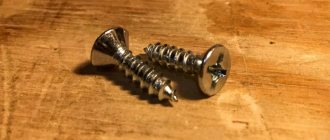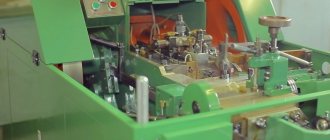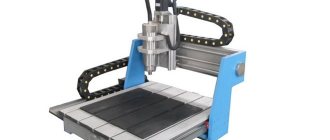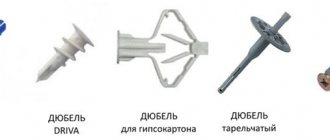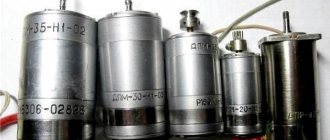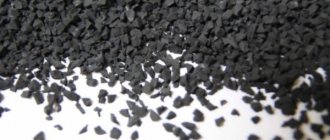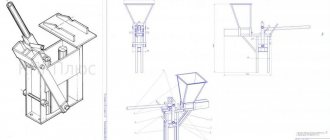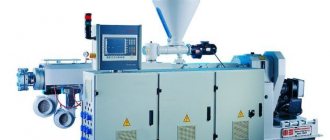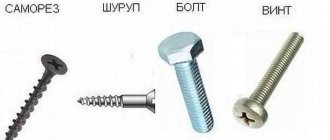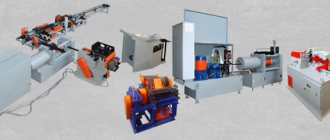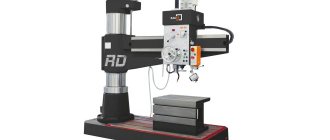What hardware is most in demand?
It produces quite a lot of hardware (means of fixing objects together). They are varied in appearance and methods of use. The most common are:
- nails. Any person has necessarily used this consumable throughout his life. They are produced in different sizes. Shoemakers use small products, the length of which does not exceed 3...5 mm. At a construction site, large nails measuring 200...300 mm are used to connect boards. For greater strength of the connection, they are also bent on the reverse side;
- screws are a continuation of the development of ordinary nails. They don't need to be hammered. For use in connections, holes are drilled and then screwed using screwdrivers or other rotary tools;
- Self-tapping screws no longer require pre-drilled holes. The pointed part of the hardware allows you to form a recess into which the self-tapping screw will be screwed. All that remains is to apply light pressure along the axis of rotation to rotate the connecting element and fix the objects in the desired form;
- Several types of rivets are used to obtain a permanent joint between parts. Structurally, they are carried out according to several schemes. Currently, blind rivets are the most convenient. All work is done on one side. There is no need to rivet the back part and form the head;
- threaded connecting elements: screws, bolts, nuts and washers for securing against rotation. The need for such hardware is difficult to overestimate. Any industrial product, from the simplest to the most complex and large, uses different types and types of threaded structures;
- auxiliary devices: angles, connecting plates, sealing washers and other items serve as elements that contribute to the better performance of traditional hardware. Modern construction and mechanical engineering widely uses a variety of products for joining parts together.
Business in the production of any hardware most often turns out to be quite profitable. Even making ordinary nails is quite promising. In some localities in the Middle Kingdom, each family produces a nail of a certain size. Later, all manufactured products are packed into boxes and distributed throughout the world.
To organize production, you need to purchase a machine for self-tapping screws or other types of hardware, as well as consumables - wire of the required diameter. All that remains is to master the production process and begin production.
Machine for forming caps on cylindrical surfaces
Hardware is produced not only abroad. The market for this product is so large that small firms with different forms of ownership are organized in the CIS, which operate machines on a continuous basis throughout the day, producing tons of in-demand products.
Machine for cold rolling of threads on self-tapping screws
Mini factories for small businesses - an overview of the best options
Today there are many ideas for developing small businesses in Russia using mini factories. This popularity is due, first of all, to the need to make small financial investments in business development.
Many investors are also attracted by the quick payback of the mini plant.
Taking into account the above reasons, we can identify several areas of production that are of great interest to Russian entrepreneurs:
- Construction.
The most popular area of activity in our country, which contributes to the emergence of a wide variety of mini factories. There are separate units for the production of concrete, paving slabs, bricks, consumable building materials, etc.
- Also has a wide range of activities. You can purchase mini factories of different directions:
- meat processing;
production of dairy products;
- production of confectionery and bakery products;
- juice production, etc.
- Garbage recycling.
This field of activity, against the backdrop of global concern about the state of the environment, is gaining great popularity in the Russian Federation. A significant advantage of such a business is approval from the authorities, which gives a chance to count on subsidies from the state.
- Light industry.
It is quite profitable to open a mini-factory for the production of textile and knitwear products (clothing, shoes), household goods, cosmetics, etc.
Whatever production area you choose, the main thing is to have knowledge in this area, analyze the competitive ability and demand for the product. This will significantly improve the efficiency of your enterprise.
Let's look at a few examples that use mini-format plants for small businesses.
Example No. 1. Brick production.
The cost of such equipment ranges from 1 million rubles and more. It is worth noting that the costs of producing bricks are quite high. Buying one piece of equipment is not enough here - you will need different equipment. Also, the purchase of raw materials takes a considerable amount of money.
For example, to make 1,000 bricks you will need about 800 kg of cement, 300 liters of water and more than 3,000 kg of basic raw materials. The power of equipment for such a business is usually very high, which also requires high costs for electricity.
How is the technological process organized?
Before starting any business whose goal is to make a profit from production activities, the market is studied. Only knowing that the goods produced will be sold can you continue to develop a project for a small or medium-sized enterprise.
To produce a certain product you need to have premises. They can be separated by partitions, but you can concentrate everything in a single space:
- point for receiving and storing raw materials. This is one of the most important rooms. Here you will have to control the imported materials. It will be necessary to allocate areas where they will be stored;
- The production area involves the placement of machines and auxiliary equipment. The main process of converting raw materials into finished products is carried out in this area;
- packaging is often taken outside the main production area. The potential buyer must receive the goods packaged in appropriate containers. The ingress of dust and other contaminants onto finished products is undesirable;
- The warehouse for finished products must allow storage for a certain period of time. Wholesale buyers do not come every day. They also have their own logistics schemes for collecting goods and transporting them to their sites.
In addition to the main buildings, auxiliary buildings can be used to house related services: accounting, technologists, labor protection specialists and management.
When creating a new enterprise or transforming an existing one, they solve transport issues:
- How to organize an uninterrupted supply of raw materials?
- On what days should raw materials be delivered?
- How to keep driveways in good condition throughout the year?
- How to organize the movement of raw materials, semi-finished products and finished products within production?
- How to load and unload vehicles?
In fact, there are many more questions. They arise when we begin to move from words to real deeds.
Equipment selection rules
When selecting machines, it is necessary to take into account their productivity, labor intensity of manufacturing processes and operational characteristics. In addition, the source material has a direct impact on the parameters of the equipment. In the vast majority of cases, machines for the production of hardware are designed for processing rolled steel made from metal of various alloys.
The minimum configuration of the line will require the following types of equipment:
- Unwinding machine. Designed for cutting wire into blanks.
- Cold heading machine. With its help, the desired shape of the product is obtained by rolling.
- Thread rolling equipment. Necessary for applying threaded lines to the surface of the material being processed.
Then the hardware products go through the hardening stage, after which they are packaged and sent to the finished product warehouse.
Development of a production scheme
It seems to the uninitiated that it is enough to purchase a machine capable of producing a certain type of product, and then everything will go on its own. In fact, it will be necessary to work out the technology, justify the modes and clarify the actual output.
Having a drawing of the future building for production, they begin to work out the features of each department.
In warehouses for raw materials, you will need to consider how and where the delivered goods will be stored.
- Wire is most often used to make hardware.
- It is stored in bays.
- The weight of each bay can reach several hundred kilograms.
- It will be necessary to lift and move using auxiliary types of lifting and transport equipment.
- During storage, it will be necessary to prevent moisture from entering the room, otherwise the wire will quickly rust and become unusable.
Therefore, the diagrams indicate some of the requirements for the raw material warehouse.
- Production requires the presence of not only the machine itself, but also an unwinder.
- The coils are installed on the unwinder; it allows for uniform feeding to the machine.
To straighten wire twisted into coils, special roller systems are used to straighten the workpieces. Equipment manufacturers talk about them last, believing that the consumer must first purchase a machine. But without straightening systems it is impossible to produce a quality product.
Many may have encountered in practice screws or nails that have certain curvatures. This occurs in cases where the production technology is not thought through to the end. There is an important element missing that was not known about.
Equipment for the production of perforated fasteners - Metalworker's Handbook
Having a good understanding of the construction industry, a professional can begin to implement almost any business project - many of the areas are characterized by high profitability.
But beginners also have every chance to launch a profitable enterprise by choosing a low-cost direction characterized by high consumer demand for the final product.
If you buy equipment for the production of hardware and establish sales contacts, you can quickly get accustomed to the market and start earning good money.
Our business assessment:
Starting investments – from 1,500,000 rubles.
Market saturation is average.
The difficulty of starting a business is 6/10.
Fastening materials always sell out well. Buyers are not only private builders, but also large developers who need this product constantly and in large volumes.
The main share of demand falls on screws, self-tapping screws, nails, bolts, and anchors.
The production of hardware and fasteners as a business suggests the presence of 2 development options - you either produce “standard” products, or take orders from large clients.
And the second scheme for the development of a small workshop is the most optimal, since it will be very difficult to compete with industry giants. And since large enterprises rarely take on orders from medium-sized businesses, you can take a strong place in the market.
How to start a hardware production plant? What should an entrepreneur take into account?
Proper business registration
It’s great if at the initial stage of business development you draw up a clear business plan. On the pages of the project you will analyze the sales market and competitors, calculate costs and possible profits.
Are you going to borrow funds from banks or private investors for the production of construction fasteners? Then you can’t do without a business plan! You must prove to lenders that the business is profitable.
And the first point of the business plan is the registration of the enterprise. To open the production of hardware and fasteners in Russia, register as an individual entrepreneur or LLC. At the same time, you will need to register with the tax office.
There is also a lot of work ahead to register the technical conditions according to which fasteners will be manufactured in the future, which will entail both monetary and time costs.
It is impossible to do without obtaining permits from sanitary and fire services - but this will already be at the stage of commissioning the line and starting the work of the workshop.
If you plan to produce and sell hardware and fasteners under your own brand, you should consider this point by registering the brand and developing an original product packaging design. But a novice entrepreneur can refuse this - he will have to wait a long time for approval from government agencies (up to a year) and will have to invest a lot of money.
How complex is the technology for producing hardware products?
The technology for producing hardware, given that all the “work” is done by machines and devices, is not complicated. But without knowing the basics at all, you still can’t do it alone - to start a smooth process, it’s better to invite a specialist in this field.
The production of stainless steel hardware will require constant supplies of steel wire of different diameters to the workshop.
The quality of the finished products will depend on the quality of the raw materials used - it’s better not to skimp on it! Some manufacturers prefer wire already cut into blanks.
This greatly simplifies the process, since you don’t have to spend money on one of the line’s machines. But at the same time, the purchase of “semi-finished products” increases the cost of finished products, which not all customers will like.
The production of hardware products is carried out using the following technology:
- Cutting blanks according to specified parameters along the length of the final product.
- Formation of the cap, slot and point.
- Thread cutting on a finished steel blank.
These are the main stages of the process that are required in the workshop. In principle, at this stage it is already possible to pack ready-made fasteners.
But the production of high-strength hardware will require the organization of other processes that are aimed at giving the products improved properties. All this will require additional equipment.
But it’s better to spend money when starting a business to ensure high quality products.
The production of furniture fasteners at further stages may consist of the following:
- Hardening in a furnace. Exposure of metal to high temperatures.
- Phosphating. A special composition is applied to the products, which during processing forms iron phosphate. The solution is heated to a certain temperature, and the fasteners are then immersed in it. This is a very economical way to improve product properties.
- Oxidation. This production of hardware products involves applying a film of oxides to the surface of the fasteners. This technique is slightly worse than phosphating, since in the end the final product is not characterized by such high strength indicators.
- Galvanizing. Applying a zinc-based protective film to nails and bolts. The technology is quite complex, which leads to higher prices for products, which is why the technique is not so often used in small enterprises.
During additional production stages, the wire used becomes stronger, is not exposed to the harmful effects of moisture, and can withstand heavy loads.
Manufacturing non-standard hardware does not mean that you need to introduce several existing techniques into production at once. For each specific customer order, you can “vary” the technology by choosing a specific processing method.
Workshop technical equipment
The hardware production line is the most impressive expense item in the entire business plan. Some types of machines may not be purchased by mini-workshops.
But there is also equipment without which it is impossible to imagine the technological chain.
Study the market for suppliers of machines and devices and choose the appropriate option based on price and functionality.
The list of equipment for the production of hardware products includes:
- Cold heading machine. Cuts wire into blanks, forms caps and points.
- Thread rolling mill. The working mechanism is equipped with special dies, with the help of which threads are cut with a given pitch.
- Hardening furnace. The internal space heats up to 920 ˚С.
- Galvanic line. Consists of several sequentially installed baths. The products are loaded into a special drum, which is then immersed in a bath with a degreaser, and then in a bath with one or another chemical composition and clean water.
- Drying centrifuge. This is an automatic machine for the production of hardware that dries finished products after treatment in a bath using hot air.
The line with the designated equipment can be fully automated. In this case, the operating personnel are only required to load raw materials and unload finished products. Not the most popular option among novice entrepreneurs, since it involves significant expenses.
The price of equipment for the production of hardware and fasteners varies widely depending on the power and level of configuration. The entrepreneur will have to spend at least 800,000 rubles on equipping the workshop.
And this will not be the most productive line - with a capacity of up to 60 units/min. In this case, the functionality of the equipment is quite limited - for the most part it cannot be reconfigured to produce dozens of types of products.
Machines producing up to 250 items per minute cost no less than 2,000,000 rubles.
You can buy a machine for the production of hardware both in Russia and abroad. European equipment is expensive; domestic entrepreneurs rarely install it in workshops.
But Asian lines are superior to many others in terms of price and quality. First of all, consider buying these.
The following brands of machines for producing fasteners have proven themselves excellent in the market: LianTeng, Candid, INNOR and FOB.
We recommend these articles:
How to open a mini-production of nails in Russia?
We are opening a mini-factory for the production of self-tapping screws.
How to write a business plan for the production of biofireplaces?
Profitability of the planned business
If we take the minimum, it will cost an entrepreneur about 1,500,000 rubles to organize an enterprise for the production of hardware.
This will include the costs of equipping the workshop, preparing it for work, and ensuring a supply of raw materials. And this figure is far from the limit.
Main technological equipment of the workshop for the production of self-tapping screws
What do you need to have to start producing self-tapping screws? The following machines are used:
- Unwinder. This equipment helps ensure uniform movement of the wire to the machine equipment.
- Cold heading is designed for forming blanks of a certain length and forming a self-tapping head.
- Thread rolling is used to form a thread of a certain profile on the body of a self-tapping screw. The edge of the future product is also created on it.
- A hardening furnace is necessary for hardening the semi-finished product. The wire used is made of carbon steel. At the stages of giving certain shapes to parts, it is desirable to have plastic raw materials. However, after forming the screws with the given parameters, it is necessary to give them additional strength. For this, heat treatment is performed. The semi-finished product is hardened.
- A tempering furnace is needed to remove residual stresses after hardening. The heating is low, only 220…250 ⁰С. This is followed by slow cooling in air.
- Parametric oven (for blackening screws). When producing ferrous products used in construction and in a number of areas of mechanical engineering, it is necessary to protect the surface of the products by bluing. The steel is blued in special furnaces. The resulting oxide film prevents metal corrosion.
- The carburization furnace is in demand when using ductile types of wire with low carbon content. Such raw materials are cheaper than carbon steel, but they cannot be hardened. There is a way out - saturate the surface layer of products with carbon by baking in special containers with coal and graphite. As a result, the surface layer becomes hard and has higher strength than the rest of the self-tapping screw.
- A bath for galvanic coating is necessary in the production of furniture screws. The surface of finished products is coated with zinc or chromium. Some consumers prefer products with bronze shades. Then solutions containing copper are used.
- Washing machines are installed at all stages of self-tapping screw production. You have to periodically remove dirt.
- The filling machine packs the required number of individual hardware into small containers. The size of the products, type of coating and quantity in the package are also indicated here.
- The packaging machine allows you to complete packaging in large containers, such as boxes or boxes. Some users prefer to purchase goods in transparent blocks. They are produced on vacuum packaging machines.
Mini-factory for the production of self-tapping screws. Productivity 25 pcs/min
In large industries, the entire specified set of machines is used. If production activities are carried out in small workshops, then some types of equipment may be missing.
Features of doing business using mini factories
Compared to large factories, starting a business using such equipment is much easier. But here too there are some nuances and peculiarities.
No. 1. Choosing a niche.
To begin with, as in any business, you need to decide in which area of production you are going to work. It is advisable that the chosen activity is close and understandable to you.
Competitiveness and demand in the region play an important role when choosing a business direction. It is best to occupy a niche that has great prospects, but has not yet gained popularity among private entrepreneurs.
Time plays a big role. The faster you start manufacturing a unique product in your region, the greater your chances of taking a leading position in this area of production.
No. 2. Business plan.
Clear and competent drafting of your own business is a very important factor in entrepreneurial activity.
For your business to be successful, you need to work on the following main points:
- Calculate all expected expenses, from the purchase of a mini plant to the cost of packaging the finished product.
- Methods of delivering products to the consumer, transportation costs.
- Search for a sales market.
- Location of mini-format plant, search for employees.
Rural areas are most often used, since the cost of land is low, and the level of wages for workers is much lower than in large metropolitan areas.
Business plan financial plan: detailed calculation
No. 3. Preparation of necessary documents.
The main advantage of opening a mini-format plant is that to start a business it will be enough to register as an Individual Entrepreneur. To do this, you should study the corresponding section of the Federal Tax Service website: https://www.nalog.ru/rn77/ip/interest/reg_ip/petition/.
Otherwise, everything happens according to the standard scheme: obtaining permission to open a mini-plant from various municipalities; inspections of the Ministry of Emergency Situations, etc.
The speed of processing documents and obtaining permission from local authorities is positively influenced by the fact that your business is associated with social significance for the area. For example, a mini waste processing plant will receive government approval. In this case, there will even be a good chance to receive financial support from the state for business development.
Step-by-step technologies for the production of hardware
The production process of wire processing involves the use of cold stamping methods:
- cylindrical blanks of a certain length are cut or chopped from wire (usually on machines you can adjust this value within certain limits);
- a head (cap) is formed on the blanks. This process is similar for all types of hardware. On nails, screws, self-tapping screws, screws and bolts;
- Thread rolling is done on other machines. First, you need to clearly orient the workpiece in space so that in this state it can be directed onto the knurling plates or rollers.
After cold stamping, heat treatment is performed. The final step in creating a self-tapping screw is to apply a protective coating.
Cold forming technology for M6 bolts
| The wire is laid on the unwinding mill. It is placed on top of special guides. The vertical shaft can rotate slowly at a set speed to feed raw materials into the process. | |
| The roller system straightens the wire. First, it is lubricated in the receiving unit with oil. The presence of lubricant prevents the formation of scoring on the surface. Then the feed is carried out between the straightening rollers. They bend it slightly by tenths of a millimeter. As a result, the “memory” of the parameters of the coil into which the wire was twisted is erased. | |
| In addition to horizontal rollers, vertical ones are used. They straighten the raw materials in a different plane. After passing through them, an even, straight cylindrical rod is formed. | |
| Special rollers with a corrugated surface feed the workpiece trimmer at a given speed. Here the length of the future product is adjusted. | |
| The formation of the cap is carried out in several stages. First, squeeze out a larger cylinder. Then an internal hexagon is created inside the cylinder. | |
| The workpieces from the first machine are collected in the receiving hopper. Then I redirect them to a thread rolling machine. In it, a thread is rolled on a cylindrical surface. | |
| The result is a modern M6 bolt with an internal hexagon. They are used in the manufacture of tools, cars, airplanes and other equipment. All that remains is to carry out hardening (the workpieces are heated to a temperature of 850...930 ⁰C, and then cooled in oil). | |
| For self-tapping screws, thread-rolling dies are often used. They hold the self-tapping screw vertically by the head. Then it is directed between the movable and fixed dies. Grooves of a given profile are extruded. | |
| When making screws and bolts, special rollers are often used for rolling threads. Such equipment allows you to obtain a high-quality surface in all parts of the product. |
What machines can you purchase to create your own production?
Having understood the technology and decided on the location, you can think about purchasing equipment. The question is often asked: “How much does a certain machine cost?”
If you purchase Russian-made machines that provide low productivity (50...70 pieces/min), then you can buy such equipment for 170...200 thousand rubles. If you want to produce with greater productivity, you will have to count on higher prices.
Chinese machines with a productivity of 250...300 pcs./min are sold at a price of 500...700 thousand rubles. If you want to use Austrian or German equipment in your own production (productivity 300...500 pcs./min), you need to count on buying two machines for 1500...2200 thousand rubles.
US manufacturers are talking a lot about their own equipment. But there is nothing to pay for other than the brand. Most often, Chinese machines manufactured under US license will be purchased. The price will include the profit of all interested parties.
Continuous conveyor oven
When it comes to stoves, they start advertising Germany. Here you should take a closer look. German ovens are good. But they are designed for continuous supply of semi-finished products. If you create a small production, then you need a batch oven.
Batch furnace of the Novosibirsk hardware plant
Raw materials are loaded into it in perforated barrels. In the same barrels they are sent to quenching tanks.
Some of the auxiliary equipment can be made independently. For many devices, the necessary drawings are published. They give the necessary explanations. Quite often, articles about technology are written by specialists. By communicating with them, you can purchase the necessary documentation for production.
Video: about the production of self-tapping screws.
Raw materials for the production of self-tapping screws
You need carbon steel wire. Of course, you can also purchase relatively cheap ones from 08kp, 10kp, 15kp steels. Just remember, you will need an additional furnace for cementation. Primary costs for equipment will be higher, but the steel of these grades is better formed. As a result, the quality of the products will be higher than those made from high-carbon steels.
If you do not want to install additional equipment, then you should pay attention to steel wire 10 20 45 30 KhGSA. Its price is 38...40 rubles/kg. The wholesale price of self-tapping screws is 150...180 rubles/kg.
Of course, there will be costs associated with production. Non-production expenses will definitely arise (there is no way to do without them). But actual production can be quite profitable.
Republished by Blog Post Promoter
Advantages of mini-factories
The main advantage of such plants is their small size. But that's not all. Mini-factories are less harmful to nature, and the products produced in them are not only not inferior in quality to the products of large factories, but even better.
A mini-factory requires a much smaller amount of resources; opening such a business in a rural area or in a small town, you can also hire people without education, thereby saving on wages; few employees are required.
Disadvantages include the difficulty of small business survival during the crisis in Russia.
The main success factor is offering products and services at a price that can compete with the products of large factories.
